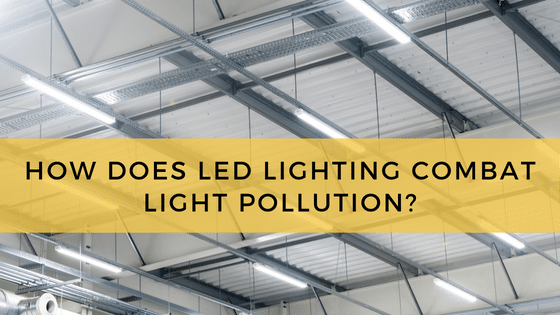
Humans and animals are adapted for dark nights. Our circadian rhythms – the daily biological cycles that govern our biological clocks – are dependent on those dark nights, and lighting pollution threatens them. Lighting pollution refers to excessive amounts of night-time illumination, often resulting in “skyglow.” That’s the orangish haze that blankets urban areas at night and creates elevated lighting conditions around the clock.
Health and lighting experts agree that lighting pollution is a problem, but LED lighting technology suggests that the problem is solvable.
What Are the Risks of Excessive Light Pollution?
The American Medical Association (AMA) has considered lighting pollution and believes it should be minimized when possible for better human health. The Illuminating Engineering Society (IES) of North America, one of the industry’s largest associations, agrees with the AMA’s assessment.
Light pollution can cause melatonin levels to drop in people, and lower levels of melatonin are associated with several health problems. They include:
● Sleep deprivation and poor-quality sleep
● Increased stress and anxiety
● Fatigue
● Headaches
Medical researchers are concerned that there could be long-term effects associated with low melatonin levels, but it’s too early to know for sure.
What’s important is that the AMA and IES agree that lighting pollution and trespass should be minimized when possible. One way to do this is with LED lighting. Some current generation fixtures are designed with light pollution-limiting features that can make for a darker night sky.
LED Fixtures Can be Engineered with Full-Cutoff Capabilities
Older street lighting systems feature non-cutoff or semi-cutoff fixtures that do a poor job of limiting light pollution. A major cause of skyglow is the uplighting that street and parking lot fixtures emit. If allowed to radiate in all directions, high-output lights generate a considerable uplight effect.
To prevent this, fixture manufacturers have created cutoff and full cutoff options designed to work with LED lighting solutions. Full cutoff fixtures can go a long way in reducing light trespassing. These fixtures provide 100 percent shielding at angles 90 degrees and above relative to the light’s nadir and 90 percent shielding in the 80 to 90-degree zone.
Fixture shielding works especially well with LED lamps because LED lighting is directional by nature. It doesn’t radiate in all directions like most other lights. Instead, it emits in a tighter spread that can be easily aimed. Even when LED lamps are shielded, they can generate high levels of output where needed most – at ground level.
Minimal Glare is also Possible with Modern LED Fixture Designs
Another significant cause of light pollution is glare. It doesn’t play a major role in skyglow, but glare is uncomfortable for people and animals. It also reflects off of surfaces, so it can trespass in unpredictable ways.
LED fixtures also offer a solution here. Some LED streetlights are built with advanced optics that act as diffusers, spreading the illumination out evenly instead of creating intense bands of light.
LED technology is ideal for this approach because LED light sources are made up of many tiny diodes. Each diode is fitted with a primary optic that orients each diode’s light in the right direction. A secondary optic fitted over the lamp diffuses this evenly distributed illumination, eliminating glare in the process.
LEDs are Available in Warmer, More Comfortable Color Temperatures
When LEDs were first adopted by cities for use in streetlights, it quickly became clear that people prefer warmer illumination at night. This was especially true in neighborhoods. Cooler color temperatures – blue light, in particular – boost attention and alertness. While this is nice during the day, at night it’s less welcome.
In the past, high pressure sodium lamps were responsible for delivering this warm illumination that people prefer. High pressure sodium bulbs, though, create low quality light that is terrible at rendering colors. That has a negative effect on long-range visibility and, therefore, safety.
When first introduced, LED lighting came in a limited variety of color temperatures, most of them on the cool side of the spectrum. Now, LED lighting is available in a full range of color temperatures, including warmer tones that people find more comfortable.
Pairing LED Lights with Modern Lighting Controls Helps Manage Output Levels
One of LED’s standout advantages is its controllability. LED lights are compatible with all modern lighting controls, giving cities and property owners better management over their lighting system.
In fact, LED streetlights are at the forefront of the smart lighting control movement. Cities around the world are experimenting with networked LED lighting systems, as these allow for centralized control at the utility. With networked controls, utilities can manage an entire system’s worth of lights at the fixture level. If the fixtures are integrated with dimmers, utilities can reduce output and light pollution in a specific area of the city. Neighborhoods are an obvious choice for this approach.
Smart controls can also use data picked up by integrated sensors to dim up or down. For example, when motion or IR sensors pick up a nearby motorist or pedestrian, the light can automatically come up in output. When no one is nearby, the light dims back down.
This isn’t just effective for light pollution. It also promotes much better energy efficiency and can reduce loads on the city’s grid.
Light pollution is a problem, but LED technology offers solutions
Night-time lighting has extended our species’ capabilities well after the sun goes down, which is great for productivity. It isn’t great for our health, though, but the lighting industry is quickly developing solutions. Many of those solutions are most effective when paired with LED lighting technology. With their superior engineering and controllability, LEDs can be adapted for a range of light pollution-limiting initiatives.






